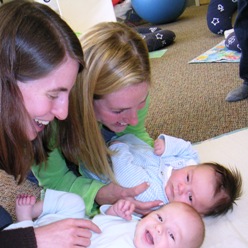Does bathing with your baby seem like an odd idea, strangely appealing, or both? Even a very young baby can go in the tub with either parent. The warm, deeper immersion is very relaxing yet stimulating to newborns and infants, perhaps reminding them of time floating in utero. You and your baby will love it, and it’s the easiest way to bathe your baby without screaming, while also earning you a nice hot soak at the end – that alone should make you a convert!
Why take a bath with your baby?
Baby’s happiness: Newborns often cry in the infant tub because only half their body is submerged in the warm water while the other half is cool. Also, the smaller amount of water tends to cool off quickly. Floating in a warm deep tub with a parent is a very different and enjoyable sensation for your baby. In the bathtub, watch your baby, with wide open eyes, calmly stretch out her arms and legs and float. It’s also very easy to wash your baby head to toe in the big tub, and it’s certainly a beautiful photo opportunity!
Bonding: Skin to skin in warm water is a delicious feeling for both parent and baby. In a breastfeeding family, having the non-nursing parent take a bath with baby offers physical closeness and is a bonding activity that has nothing to do with feeding and changing diapers. Partners enjoy having a special activity to share with baby, and being the one to have a regular baby-bathing routine. If dad feels a little funny about it, he can wear boxers or swim trunks.
Start any time: Some parents begin co-bathing during baby’s very first week – you don’t need to wait for a newborn’s cord to fall off before giving an immersion bath. Simply dry the area around the cord gently after bathing. Some parents find co-bathing a perfect remedy to a young baby who screams in the infant tub, or who no longer fits in the baby tub but is still too young to sit alone in the big tub. At any rate, there’s no age or time limit on co-bathing – it’s neither too soon nor too late to give it a try.
How to do it: Set up for Safety and Success
Prepare the tub: Your bathtub doesn’t have to be especially large or pristine. Rinse out the tub, and then fill it deeply with water that is quite warm – not as steamy as you’d like if you were bathing for relaxation, but not lukewarm either. Don’t use bubble bath, this is irritating to baby skin.
Prepare the room: Gather what you’ll need for washing your baby, and set up a diaper, lotion and clothing for afterwards. Keep the bathroom door closed while you’re filling the tub, to create a warm and humid room environment. Set up your baby’s bouncer seat or car seat, lined with a bath towel and cloth diaper, right next to the tub. Place your naked baby in the seat and then get into the tub yourself.
In and out safely: Once you’re safely sitting in the tub, reach over and pick up baby from her seat. When exiting the tub, do the same thing in reverse: while still sitting in the tub, lean over and place baby back in her lined seat and cover with the towel before exiting the tub yourself. This way you’ll avoid needing to climb in or out of the tub while holding your baby.
Floating in the Bath: With your hand behind baby’s head, allow your baby to freely float – she’ll LOVE the deep warm water. Watch her arms and legs stretch out, wave and kick. Your baby’s eyes may open wide open in amazement while she remains calm and alert throughout the bath. This is the perfect time for your partner to take some photos!
Don’t drink the water: Always keep your baby’s chin above the water line. Babies may try to lap at water they feel near their lips. Try to avoid your baby’s drinking of the bath water (though a lap or lick of water will not harm your baby). If you notice that your baby pees, don’t worry! Baby urine is a tiny amount and essentially sterile and is no problem in the tub. Poop, however, does end the fun – fortunately, it’s a rare occurrence!
The Hand-Off: If your partner is home, arrange to “hand off” baby after her bath. Your partner can get baby soothed, moisturized, diapered and dressed – all without your interference. All the while, YOU can add more hot water to the tub and soak for another 20 minutes! This may be the only time all day you’ve spent caring for yourself or having your own space. When you’re in the tub, you also can’t hover, help, critique or multitask. Just sit there, relax and soak.
 Unlike other types of infant massage, this one has very specific hand movements and a very specific purpose. To gently stimulate peristalsis, to encourage motility of intestinal contents (BM and gas), to provide a “cueing sound”, and finally to offer something for baby to strain against.
Unlike other types of infant massage, this one has very specific hand movements and a very specific purpose. To gently stimulate peristalsis, to encourage motility of intestinal contents (BM and gas), to provide a “cueing sound”, and finally to offer something for baby to strain against.